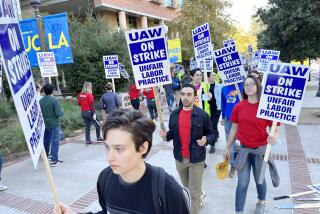From Honeymoon to Hot Seat for Supt. Romer
After a first year in which former Colorado Gov. Roy Romer wowed Los Angeles power brokers and projected an image of competence atop the nation’s second-largest school district, he is starting to face the sort of battering that was a fact of life for his predecessors.
It began with a grand jury report last month finding that the Los Angeles school system is too large to be effective. Then the state auditor said the district’s reorganization had fallen short of expectations and that district administrators are overpaid.
The state controller followed up this week with a bill for $120 million for alleged attendance inflation that occurred before Romer came on board.
The criticism is bubbling up from inside as well.
An internal study circulated to the board in July slammed the district’s computer systems as fragmented and inadequate. And district Inspector General Don Mullinax, who had kept relatively quiet since Romer took over, released seven audits in June pointing to management breakdowns:
* In the accounts payable section, auditors uncovered more than $3 million in checks that were never sent and are now too old to deliver. More than 2,000 unpaid invoices from 1998 were stored in a file cabinet.
* Adult schools were holding classes with far fewer than the mandated minimum of 18 students. In the worst case a teacher instructed a single student for 13 weeks.
* Cafeteria managers at four of 11 schools sampled were unable to account for thousands of federal meal ticket books.
Not even the most optimistic reformer expected the new superintendent to fix the district’s notoriously backward business operations in a single year. But the recent crescendo of unfavorable reviews underscores the gargantuan task and has put Romer on notice that the district’s problems are squarely on his watch.
Even some staunch supporters are growing impatient for results. Board President Caprice Young praises the superintendent’s achievements in reshaping instruction and assembling capable management for a massive program to build 85 schools. But she wants him to work harder on improving business operations.
“I fault him for not focusing enough on developing organizational capacity around boring things like contracting, human resources, finance and technology,” Young said. “I believe that if he brings the same kind of passion and drive to those issues that he’s brought to academic achievement, we will turn this school district around.”
In addition to the audits, Romer has caught flak over the abrupt departure of two key senior staff members in June. Chief Operating Officer Allen Solomon left after two months because the job offered less authority than he expected. George McKenna, the superintendent of one of the 11 subdistricts, resigned rather than remove two subordinates, as Romer demanded.
Although the board refrained from commenting on the two snags, some media questioned the buyouts for the two men totaling nearly $350,000.
Romer strongly disputes much of the criticism. He contended that the buyouts were necessary. In Solomon’s case, he said, it was a legal obligation because the chief operating officer had left a highly paid job to come to the district.
The superintendent blasted the outside attacks from the grand jury and state auditor as just plain wrong.
The grand jury, he said, was “a group of well-intentioned citizens who didn’t do close to enough work in their research to be accurate.”
Indeed, the report was rife with grammatical and factual errors. But Romer just as vehemently disputed the state audit. He ridiculed, for example, the assertion that he should have compiled detailed salary comparisons before hiring highly paid administrators, such as General Counsel Hal Kwalwasser, who receives $225,000 a year.
“Come off it,” he said. “When I’m out trying to hire a lawyer, I don’t need to get a detailed study of what you pay general counsels. I know what you pay general counsels because the marketplace tells me about it.”
He trumpeted two of the district’s own audits, which found no significant problems, and downplayed the problems cited in the others as the kind of mix-ups that are inevitable in any large institution.
“Look, auditors have got to find something to write about,” he said. “You have to have some sense of balance on it.”
Pointing at the adult school audit, for example, he said the auditor’s total exceptions for small classes cost $712,000, representing 0.4% of the division’s budget.
Board President Young said she thinks Romer ought to be more open to criticism.
“If we’re going to turn this system around, we can’t be defensive about it,” Young said. “Yes, it’s screwed up. Let’s fix it.”
Romer denied that he is being defensive.
In fact, he acknowledged problems in the district’s chaotic computer systems, which are critical to everything from purchasing and payroll to student records. His office hired the consultant who made the critical findings.
“We have a very large set of problems in this section,” Romer said. “It’s something that has accumulated over many years. We have very serious awareness of it and the intention to change it.”
The report, by outside auditors KPMG, found “islands of dedicated people trying to do the right thing” while hampered by “fragmented organization,” “costly support for obsolete equipment” and “lack of districtwide network strategy.”
There are too many vendors who provide too little service, and too many “home-grown solutions,” it said. The system lacks basic protections against hacking, and some of its most important functions, such as payroll, still rely on “highly manual processes.”
Those conclusions bear a striking resemblance to the findings of outside consultants as far back as 1993. At that time, an Arthur Andersen management audit urged the district to computerize its cut-and-paste information system.
Four years later, the same firm found the effort bogged down in “an environment of complacency, finger-pointing and low productivity.”
In his report on the finances of the Belmont Learning Complex, Mullinax found billing problems that were partly to blame for the waste of millions of dollars. The high school project has been mothballed for two years because of environmental concerns. He said the district needed a chief information officer to oversee all computer operations.
Romer acted on that recommendation in December, filling the new $190,000-a-year position with Margaret Klee, a Navy captain who was then chief executive officer for the Naval Computer and Telecommunications Station in San Diego.
Klee said she found the district’s problems typical of what happens in any large organization that develops computer systems without an overarching plan.
“Nobody has stepped back and looked at it and said, ‘Does any of this stuff make sense together?’ ” she said.
Klee brings a can-do attitude to the job.
“My bottom line is: We studied this enough,” she said. “Let’s do it.”
Klee said it will take six months to design a new system master plan and weed out a hydra-headed telephone system that has been patched together by vendors who sometimes installed unnecessary equipment.
“It’s going to take several years to actually make some of these problems go away,” she said. “They didn’t arrive overnight.”
In delivering the latest broadside against the district, state Controller Kathleen Connell carefully avoided blaming Romer for attendance accounting lapses that occurred before he was on the job.
The audit covered the 1996-97 school year, the last in which the state paid for the “attendance” of students who were absent with an excuse.
Citing inadequate documentation, the state disqualified 27% of the excused absences Los Angeles Unified reported. Because that year was the baseline for an increase in per-student reimbursement, the state auditors said the district should be docked $42 per student from then on.
District officials contested the controller’s approach.
Chief Financial Officer Joe Zeronian said he will recommend an appeal because the state auditors tossed out many records because they were not filled out to the last detail.
Connell said her office already adjusted the bill from $154 million to $120 million. She was not sympathetic to the district’s protests.
“If you got an audit notice from the IRS, you are expected to come into your audit conference with all your records,” she said.
But Connell said she’s talked to Romer and school board members, and believes they are focused on establishing better financial controls so such problems won’t continue.
“I don’t fault the current administration,” she said. As far as Romer is concerned, part of his job is taking hits, whether he thinks they’re justified or not.
He scoffs at the suggestion that a honeymoon period is ending. He contends there’s never been one.
“I get it every day,” he said. “I don’t know if there’s any more of it this month or last month.”
More to Read
Start your day right
Sign up for Essential California for news, features and recommendations from the L.A. Times and beyond in your inbox six days a week.
You may occasionally receive promotional content from the Los Angeles Times.







